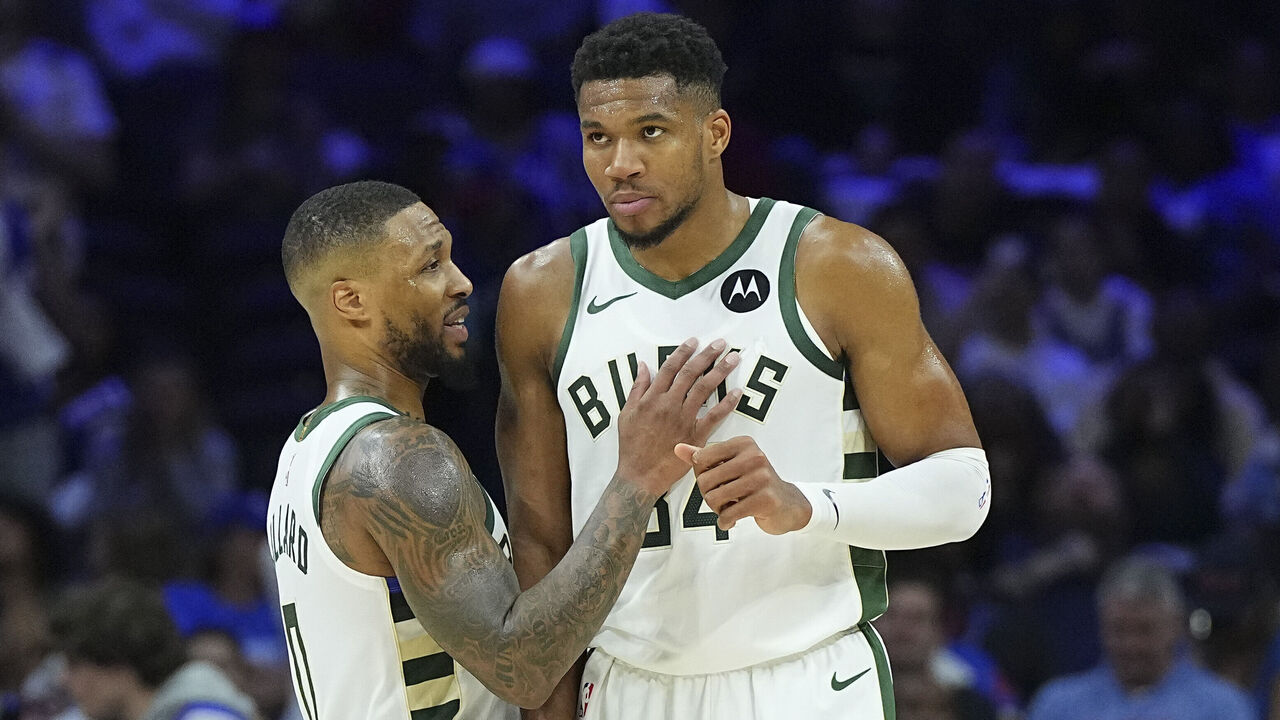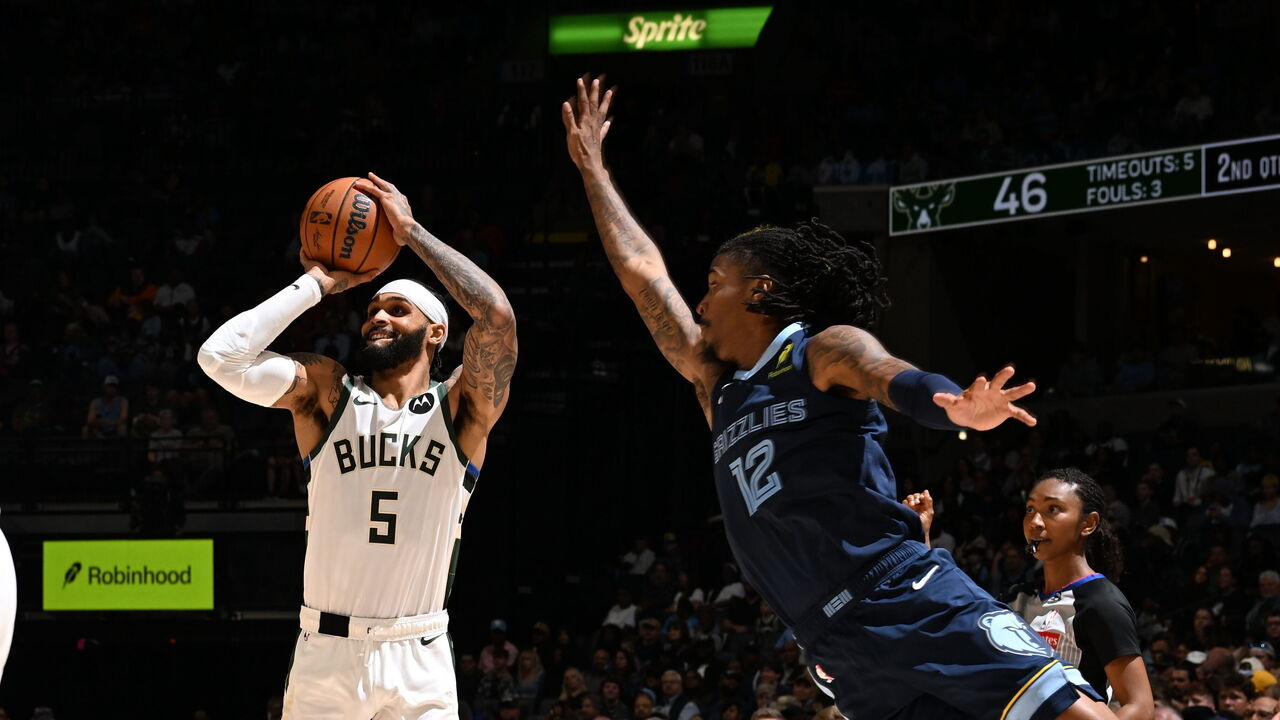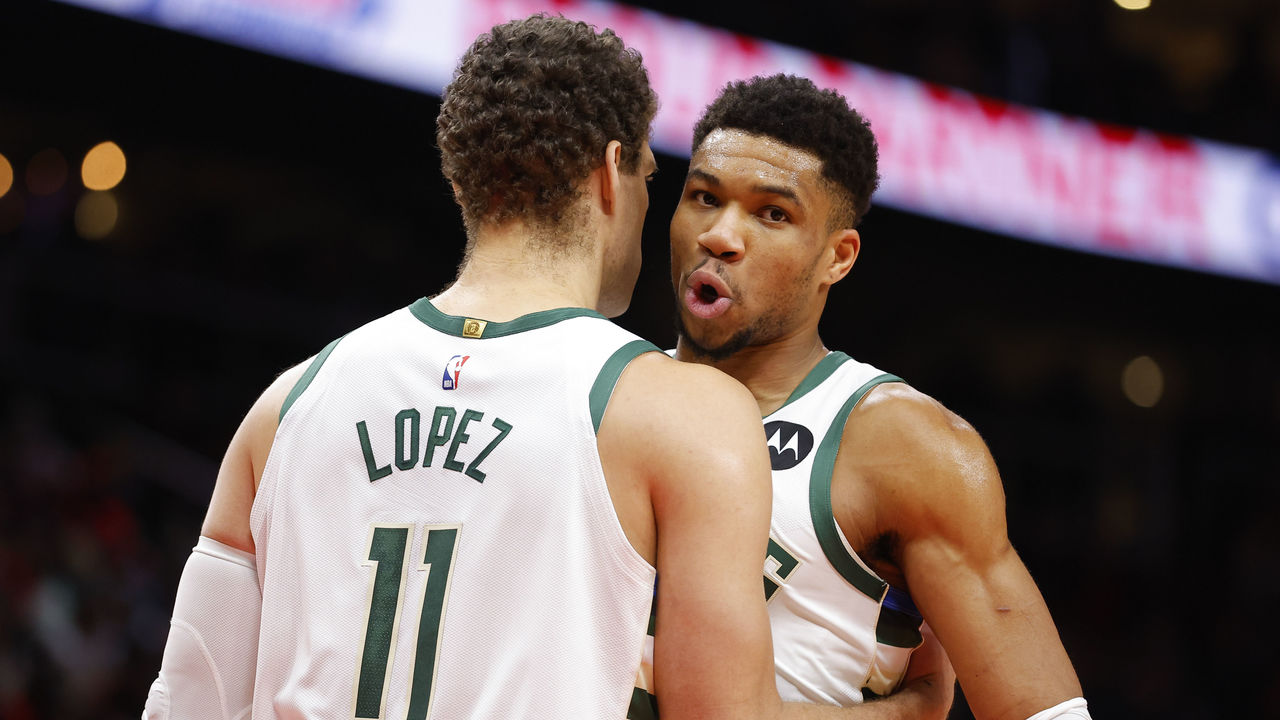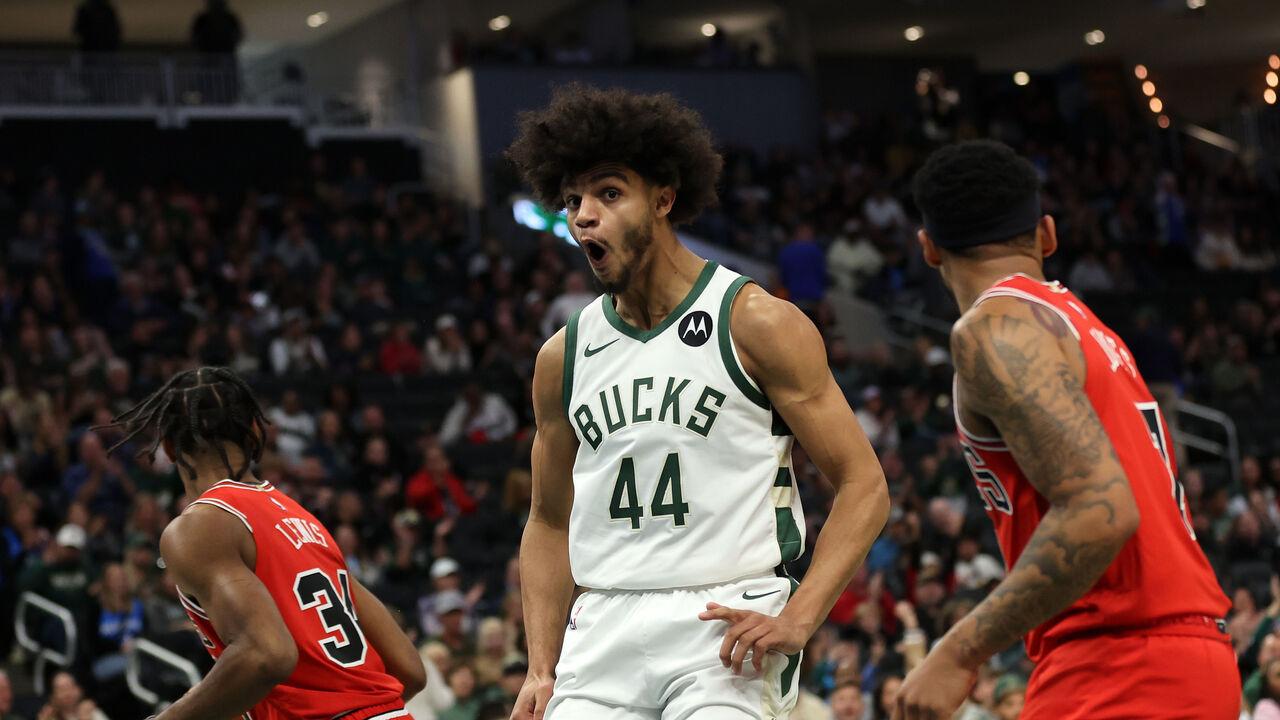Searching for optimism in the Bucks' disastrous start
Anyone paying attention to the NBA season knows full well the precarious spot the Milwaukee Bucks are in. Despite the aging team trading away virtually all of its long-term assets to contend for championships right now, Milwaukee has started the campaign 2-7, with bottom-10 marks on both ends of the court.
We don't need to relitigate the moves that brought the Bucks here, or ponder the bleakness of their future. That's been done to death. Instead, let's do something different and try to find some glimmers of hope in Milwaukee.
Here are a few reasons to believe this team can overcome a disastrous start and turn its season around.
Reason No. 1
Dame and Giannis look like Dame and Giannis

Maybe the biggest question for the Bucks coming into this campaign was whether Damian Lillard's underwhelming 2023-24 represented a brief blip brought on by chaotic circumstances or the new reality for a 34-year-old star in decline. If these first nine games are any indication, the answer is resoundingly the former. Even with a 1-for-12 shooting night on the ledger, Lillard is averaging roughly 27 points and seven assists on 63% true shooting.
His 3-point shooting has rebounded, but more importantly, he's back up to 56% from 2-point range after dipping to 49% last season. Lillard's deadly pull-up game and absurd range may be his standout skills, but driving has always been his secret superpower, and he's reconnected with it this season. He looks nimble and explosive while attacking backpedaling bigs, and he's showcasing his refined finishing craft while shooting a career-best 67% at the rim. That, as much as his 37% mark on over nine 3-point attempts a game, is why Lillard's averaging 1.15 points per possession as both a pick-and-roll ball-handler (up from 0.99 last season) and an isolation scorer (up from 0.96), per NBA Advanced Stats.
There was never any doubt that Giannis Antetokounmpo would continue to be a dominant offensive force this season, but averaging 30-13-5 on elite efficiency can't be taken for granted. He's completely eschewed the 3-point line (having attempted just four triples across eight games), instead focusing on mashing dudes in the paint. Antetokounmpo's average shot distance (5.8 feet) is the shortest of his career, and his 12.6 shots per contest inside the restricted area are 3.4 clear of any other player. He's also leading the league in transition scoring for the seventh straight year, uncorking an array of full-extension layups and Statue of Liberty dunks on the break.
Crucially, Lillard and Antetokounmpo are looking smoother in tandem than last season. They've gotten a better sense of each other's timing and rhythm flowing into and out of ball-screen action, and the Bucks are running more empty-corner pick-and-rolls and DHOs for them, which provides Antetokounmpo cleaner rolling lanes. He's also sharpened his short-roll decision-making when defenses send aggressive tags, something he struggled with at points last campaign.
Milwaukee could still stand to run more inverted actions involving the two of them. However, their synergy looks improved when Antetokounmpo has the ball because Lillard has gotten better at forming up around his drives, while the two-time MVP has gotten better at looking (or no-looking) for Dame on kickouts.
Reason No. 2
Offense can be a lot better

Given the eye-popping production offered by the team's two stars, it wouldn't take much more than competent role-player contributions to make Milwaukee a top-10 offense. Unfortunately, the Bucks haven't gotten anything approaching competence from said role players, which is why they rank 22nd. Expect that to change, even if the supporting cast here is far from ideal.
The gravity Antetokounmpo and Lillard carry, individually and collectively, creates a ton of quality looks for others. As such, the Bucks generate plenty of catch-and-shoot 3-point attempts. The problem is they rank 25th in accuracy on those looks, including 22nd on wide-open threes, per NBA Advanced Stats. They may not be an elite shooting team, but they should be a lot better than that, especially when you consider the guys who've gotten most of those clean threes are Gary Trent Jr., Brook Lopez, and Bobby Portis. That trio combined to shoot 45.2% on open triples last season (with Trent's 51.3% leading all players with at least 100 such attempts) but is at 27.7% this campaign, per NBA Advanced Stats.
I'm burying the lede a bit here, but Khris Middleton's return will obviously help immensely on this front. Even if two surgically repaired ankles compromise his movement, it's impossible to overstate how helpful his shooting and secondary ball-handling will be for a team with those things in short supply. There's a reason Milwaukee has an offensive rating of 98.9 when Lillard's on the bench, compared to 115.3 with him on the court. That offensive rating was 115 last season when Middleton was on and Lillard was off. And when the two of them and Antetokounmpo all shared the court, it was 125.6.
Reason No. 3
Defense can be ... a little bit better? Maybe?

I'm not going to mince words: Milwaukee's defense has been very bad, and the process hasn't been any better than the results.
The Bucks' screen navigation might be the worst in the league. Lillard has always struggled with that, but Trent, Taurean Prince, and Pat Connaughton haven't been much better. (Trent has arguably been worse). The club signed Delon Wright to help in that department, but he's been ineffective.
The inability to maintain contact around screens or apply any rearview pressure impacts everything the team does defensively. It means Lopez has to play higher up in ball-screen coverage than he's comfortable with, causing the Bucks to wind up emergency late-switching (or miscommunicating would-be late switches) quite a lot. It's also probably a big part of why they're playing so much ICE coverage, which is helpful because it's designed to prevent ball-handlers from using the screens but comes with drawbacks (like pulling a third defender into the action on the back side), and is easy to exploit if the on-ball defender doesn't actually force the ball to the sideline.
So, what exactly is there to be optimistic about on this end?
For one thing, Lopez is still one of the best back-line anchors in the game. He's holding opponents to 45.6% shooting at the rim, the fifth-best mark for players contesting at least four such shots per contest. And the Bucks as a team are doing a fantastic job deterring those shots, ranking second in the league in opponent rim frequency despite all the dribble penetration their point-of-attack defenders are conceding. With a starting lineup change that will help shore up the perimeter (more on that shortly), Lopez's paint protection could again carry the day.
The same goes for Antetokoumpo, who hasn't been up to his usual defensive standards to start this campaign but hasn't seen much of a dropoff athletically. He should be expected to improve, just as he did over the course of 2023-24. Milwaukee's defensive turnaround in the second half of last season was less about coaching changes or scheme adjustments and more about Antetokoumpo shedding his weird malaise and re-emerging as the roving, space-devouring monster we'd come to know. We can acknowledge that he isn't quite the DPOY-caliber wrecker he once was while also believing he can be a more disruptive helper than we've seen through these eight games.
For a veteran team, Milwaukee has made a staggering number of mental mistakes in the early going - blown low-man rotations, multiple defenders rotating to the same person, ball-watching leading to backdoor cuts, and lapses in focus leading to simple face cuts. No one has been exempt. Even with a couple of rotation players who could be deemed low-feel defenders, the team should be able to clean up a lot of that stuff, especially the breakdowns in the open floor.
The Bucks aren't even giving up that many transition opportunities - 12th-fewest in the league, per Cleaning the Glass - but they've been so bad at defending those possessions (allowing 141.8 points per 100) that their transition defense still ranks 28th. That may feel like a continuation of a trend from last campaign, but the club cleaned up its act after Doc Rivers took over, to the point that its transition D ranked inside the top 10 by season's end. We know the Bucks are capable of better.
Milwaukee's struggles in that department are particularly galling considering it's punting on crashing for second-chance opportunities (ranking dead last in offensive rebound rate) for the sake of getting back in transition despite much of the league rejecting the old orthodoxy about that tradeoff. The team's also getting torched on runouts after makes, which are breakdowns that don't necessarily get logged as transition possessions. According to Inpredictable, the Bucks allow the sixth-fastest opponent time to shoot following made baskets and the third-highest effective field-goal percentage on those possessions.
Part of that is a natural consequence of being an older, slower team. Still, in many cases, it's just a basic lack of effort, awareness, and attention to detail. Maybe those issues will linger, but don't dismiss the possibility of them correcting themselves, especially if we see more of this guy ...
Reason No. 4
Emergence of Andre Jackson Jr.

Maybe it's damning that one of Milwaukee's few causes for encouragement is a 23-year-old sophomore who barely looks at the rim on offense, has turned the ball over on 28% of his used possessions, and averages a foul-out every 38 minutes. But despite those flaws, Jackson has a chance to be a transformational role player for the Bucks, offering a sorely needed jolt of athleticism, ball pressure, and event creation. And it's notable that Rivers, who doesn't exactly have a reputation for trusting youngsters, relented as quickly as he did and plugged Jackson into the starting lineup in place of Trent.
The Lillard-Trent backcourt clearly wasn't working, with the Bucks bleeding 122.2 points per 100 possessions in their shared minutes. Conversely, they've won Jackson's minutes by 5.3 points per 100, with a 104.5 defensive rating. He isn't a perfect defender - he can be overzealous, as his foul rate indicates - but you accept the tradeoffs for a guy who ranks sixth among qualified players in steals (2.9) and 10th in deflections (4.6) per 36 minutes. That's especially true for a defense that ranks 27th in forcing turnovers, which limits what could be a prolific transition attack. Jackson's the only guy on the team Rivers can count on to provide full-court pressure without getting blown by.
He's only played 118 minutes, and his limitations could get exposed in a larger sample (as the kind of did against the Knicks on Friday night). Jackson has basically no track record as a 3-point shooter (29% in college, 37% on 59 total attempts in the NBA), and he doesn't trust himself as a finisher, with a bad habit of passing out of semi-contested layups in the dunker spot. But that doesn't mean he's without offensive utility. On top of the steals that can turn into transition jailbreaks, he's shown good cutting instincts, solid connective passing chops, and highly advanced screening craft for a wing.
Rather than being marginalized when Middleton returns, Jackson could become even more valuable since the stuff he can't do on offense will matter less than the myriad micro advantages he can provide. When that happens, there's a good argument to be made that it should be Prince, not Jackson, who goes to the bench.
Joe Wolfond covers the NBA for theScore.
HEADLINES
- Report: Suns trade 2031 1st-rounder to Jazz for 3 future picks
- Jokic records 19th triple-double of season, Nuggets blast 76ers
- Risacher out at least 1 more week with strained adductor
- NBA MVP Rankings: SGA in pole position for silverware
- LeBron becomes 2nd 40-year-old with triple-double, Lakers beat Wizards